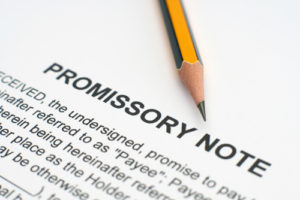When purchasing real estate with financing, you typically need to sign two specific documents to borrow money: a mortgage and a promissory note. In some states it is a deed of trust and a promissory note.
For note investors and new homeowners, understanding the difference between the two documents can sometimes be challenging.
Let’s take a look at mortgages vs. promissory notes to provide a better understanding.
Mortgages Vs. Promissory Notes: What’s the Difference?
Promissory Notes
 In the simplest terms, a promissory note is an IOU. In legal terms,
In the simplest terms, a promissory note is an IOU. In legal terms,
the promissory note is the contract that establishes the loan with the promise to pay back the amount borrowed. It outlines the obligation to pay back the loan and the central terms of that loan, which include:
- names of the borrowers
- address of the property
- interest rate (adjustable or fixed)
- amount of the loan
- late fee amounts
- the term (time it takes to repay the debt).
Unlike a deed of trust or mortgage, the promissory note is typically not recorded in the county land records (except in a few states like Florida). Instead, the lender holds on to this document until the amount borrowed is repaid.
When the debt has been completely paid, the promissory note will be returned to the borrowers and marked “Paid In Full”.
Mortgages and Deeds of Trust
The primary purpose of a mortgage or deed of trust is to provide security for the loan. It is the document that establishes a lien against the real estate pledged as collateral.
In addition to the standard agreement between the borrower and lender, the mortgage will also contain an acceleration clause.
This clause allows the lender to demand that the loan be paid in full if the borrower defaults on the loan (by not making the required payments on time, for example).
Outlined in the mortgage, the lender can foreclose the property if the borrower does not pay the debt established in the promissory note.
In most cases, the lender is required to provide notice before they can accelerate or foreclose on a loan. Then, if the borrower does not remedy the default, the lender can begin the foreclosure process.
Furthermore, a mortgage will outline:
- the promissory note being secured
- default provisions
- names of the borrowers
- the legal description of the property
Unlike the promissory note, the mortgage is recorded in the county land records shortly after it’s signed.
When the loan is fully paid, the lender will record a release known as a satisfaction of mortgage or reconveyance of the deed of trust in the county land records.
Selling A Note
It is common for lenders and investors to buy and sell promissory notes. This transfer of ownership also includes two important documents.
The Note Endorsement – The current holder of the note signs over their rights to collect the debt to the new holder using an endorsement. It is similar to endorsing over a check. The endorsement goes on the original note or on a separate attachment called an allonge.
The Assignment – The assignment of mortgage (or assignment of deed of trust) is the document that transfers the rights to the lien against the real estate. It is recorded in the same county records as the original Mortgage or Trust Deed.
So, Why Do We Have Both A Note And A Mortgage?
The promissory note is the borrower’s promise to pay the lender. It also establishes the basic terms of the real estate loan.
The mortgage is a more descriptive and extensive document that secures the promissory note. If the promissory note isn’t honored, the mortgage details the process to satisfy the debt, which usually ends in foreclosure on the property.
Knowing the difference between the two documents will help tremendously with navigating the process of buying or selling real estate and real estate notes.
